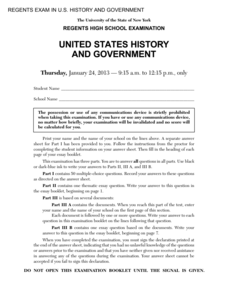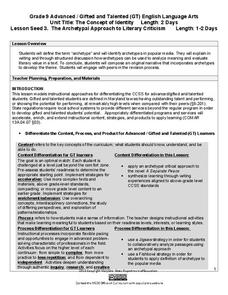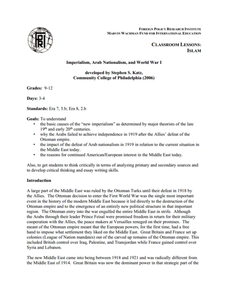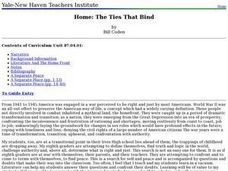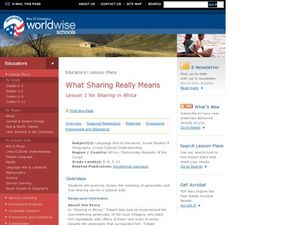New York State Education Department
US History and Government Examination: January 2013
While the 1950s seemed to be a time of peace and prosperity, Sputnik, the Korean War, and the Montgomery bus boycott were symptoms of the turmoil that loomed under the surface. Using documents, class members investigate what these events...
Maryland Department of Education
The Concept of Identity Lesson 2: The Historical/Biographical Approach
"How does our environment shape our identity?" After researching biographical information about John Knowles and considering how these experiences are reflected in A Separate Peace, class members consider the strengths and weaknesses of...
Maryland Department of Education
The Concept of Identity Lesson 5: Motivation - Maslow's Hierarchy of Needs
Maslow's Hierarchy of Needs provides the lens class members use to analyze and evaluate the motivations of the characters in Sylvia Plath's "Initiation" and scenes from Mean Girls. Readers then select a character from A Separate...
Maryland Department of Education
The Concept of Identity Lesson 3: The Archetypal Approach to Literary Criticism
As class members continue their study of approaches to literary criticism, readers examine the symbolism and archetypal patterns in John Knowles' A Separate Peace, and how these parallels are used to develop a theme in the story.
Curated OER
Africa Colors a Destiny
Students discover the peace corps and the culture of Chad. In this cultural awareness activity, students watch a slide show and examine various primary sources from peace corps volunteers in Africa. This activity includes web-links,...
Japan Society
Japan in the World Since 1945
What have US-Japanese relations been like since the conclusion of World War II? Why do some commentators identify Japan's postwar years as a subordinate independence? Invite your young historians to research Japan's status in the world...
Curated OER
The Debate in the United States over the League of Nations: League of Nations Basics
High schoolers describe Woodrow Wilson's concepts for peace and the League of Nations and efforts to foster American support for it.
Foreign Policy Research Institute
Imperialism, Arab Nationalism and World War I
Continued conflict in the Middle East makes this activity relevant, and the inclusion of a critique of Lawrence of Arabia might increase student interest in a potentially challenging topic. The resource includes a solid introduction to...
Center for History Education
Who Burned the Peggy Stewart?
Not all Patriots were on the same page against the British before the Revolutionary War. While some wanted to use peaceful means, such as debate and petition, others used violence, such as burning ships carrying British tea. Using...
Curated OER
American Idealist Lesson 2: Sargent Shriver and Public Service
Students explore the public service contributions of Sargent Shriver. In this public service instructional activity, students explore the work of the Peace Corps and investigate other service learning opportunities.
Curated OER
WWI Document Based Essay
Learners read various primary source documents on World War I. After reading each document, they answer discussion questions. Using the internet, they identify the causes of World War I as layed out by President Wilson and his reasons...
Curated OER
Appeasement Student Worksheet
In this World War II worksheet, learners read a 1-page selection about Appeasement as well as Internet articles about the topic and then respond to 7 short answer questions.
Curated OER
The Advantages and Disadvantages of the Treaty of Versailles
Students identify the advantages and disadvantages of the Treaty of Versailles. Using the text of the treaty, they discover it created more tension between groups then bringing peace to the region. They discuss how this treaty could have...
Curated OER
Debates Over Suspension of the Writ of Habeas Corpus
Eighth graders study the concept of Habeas Corpus. In this Civil War lesson, 8th graders research the reasons for and against suspending the writ of habeas corpus. Students analyze various documents.
Curated OER
Home: The Ties That Bind
Students read two novels, The Human Comedy and A Separate Peace and an autobiographical memoir, Farewell to Manzanar. They focus on the difficulties faced by the teenage protagonists in order to set up a connection between adolescence...
Curated OER
Killing Fields
Pupils view a television program that explores people's perceptions and expectations in war prior to and after WWI. They discuss the effects of trench warfare and write a journal entry or short oral report reflecting on their...
Curated OER
Devotion
Students explore the importance of peace and working together when discussing different religions and places where students are not allowed to be together. In this working together lesson plan, students plan a fund raising activity to...
Curated OER
Atlanta and Sherman's March to the Sea
Students explore the impact of William Tecumseh Sherman's actions during the Civil War.
Curated OER
Treaty of Versailles Vs. MAGIC
For this end of World Wars I and II worksheet, students respond to 6 short answer questions pertaining to the Treaty of Versailles and other peace agreements.
Curated OER
Revisiting the Somme
Learners consider how the military folly of the Somme during World War I. In this World War I lesson, students visit selected websites to discover information about the Somme, propaganda, and their effects on the war.
Curated OER
Troop Surge vs. Redeployment
Students explore American foreign policy regarding the war in Iraq. In this Iraq debate lesson, students examine videos and documents about the pros and cons of keeping American troops in Iraq.
Curated OER
Current Spanish History 1900-present
Tenth graders study the Spanish Civil War. In this World History lesson, 10th graders analyze famous paintings. Students compare and contrast the government of the United States with that of Spain.
Curated OER
Soviet Suspicions and the Search of Security
In this Cold War worksheet, students read a 1-page selection about Soviet security and then respond to 3 short answer questions.
Curated OER
What Sharing Really Means
Students examine the meaning of generosity and how sharing can be a cultural trait. In this cultural trait instructional activity, students read a text about the culture of generosity in Africa. Students complete a discussion activity...
Other popular searches
- War and Peace Tolstoy
- 1980s War and Peace
- Drama War and Peace
- Russia War and Peace
- War and Peace Tplstoy
- War and Peace Activities
- World War I Peace
- Peace or War Songs


